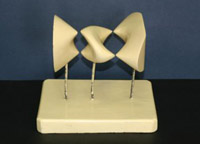This is the text of the poster you can see here.
A classical, still current, problem in Algebraic Geometry is the investigation of surfaces of a given degree with the maximum number of singular isolated points of a given type. For example, for quadrics the special singularities are called ordinary double points; their maximum number is one. For cubics, the maximum number is 4.
The model below here on the left, gives an example of a cubic with 4 double points.
For quartics, the maximum number of such singularities is 16. A quartic surface with 16 isolated double points is called Kummer surface and you can see an example of it in the model below here on the left.
Actually, the models below here are called Kummer surfaces too,although you see just 4 or 8 double points. These surfaces have other double points that we can not see in real space. They are double points that you can see in an “extended” space where the coordinates are complex numbers.
The story of the challenge to “rearrange” these surfaces is the fascinating story of a victory, but, most of all, it is a relevant example of what is meant by “making math”.
Guido Castelnuovo described it in this way:
“We had created, in an abstract sense of course, a large number of models of surfaces in our space or in higher space; and we had split these models, so to speak, between two display windows. One contained regular surfaces for which everything proceeded as it would be in the best of all possible worlds; analogy allowed the most salient properties of plane curves to be transferred to these. When, however, we tried to check these properties on the surfaces in the other display, that is on the irregular ones, our troubles began, and exceptions of all kind would crop up. With the afore mentioned procedure, which can be likened to the type used in experimental sciences, we managed to establish some distinctive characters between the two surface families. We tested these properties by constructing new models. If they passed the test, the last step of our investigation was to look for a logic argument.”



